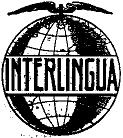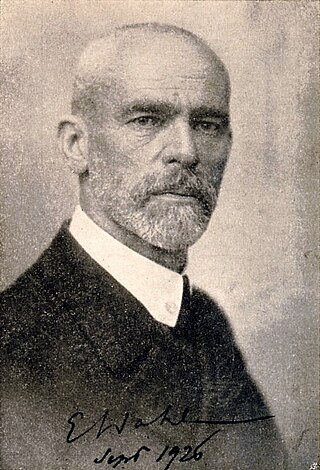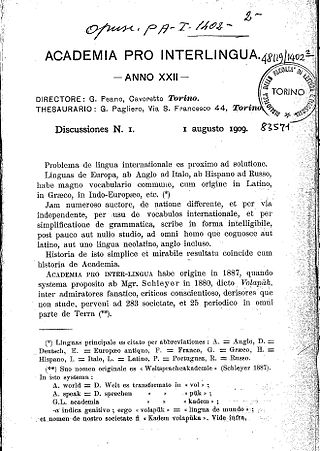
Giuseppe Peano was an Italian mathematician and glottologist. The author of over 200 books and papers, he was a founder of mathematical logic and set theory, to which he contributed much notation. The standard axiomatization of the natural numbers is named the Peano axioms in his honor. As part of this effort, he made key contributions to the modern rigorous and systematic treatment of the method of mathematical induction. He spent most of his career teaching mathematics at the University of Turin. He also wrote an international auxiliary language, Latino sine flexione, which is a simplified version of Classical Latin. Most of his books and papers are in Latino sine flexione, while others are in Italian.

Interlingua is an international auxiliary language (IAL) developed between 1937 and 1951 by the American International Auxiliary Language Association (IALA). It is a constructed language of the "naturalistic" variety, whose vocabulary, grammar, and other characteristics are derived from natural languages. Interlingua literature maintains that (written) Interlingua is comprehensible to the hundreds of millions of people who speak Romance languages, though it is actively spoken by only a few hundred.

Interlingue, originally Occidental ( ), is an international auxiliary language created in 1922 and renamed in 1949. Its creator, Edgar de Wahl, sought to achieve maximal grammatical regularity and natural character. The vocabulary is based on pre-existing words from various languages and a derivational system which uses recognized prefixes and suffixes.
An international auxiliary language is a language meant for communication between people from all different nations, who do not share a common first language. An auxiliary language is primarily a foreign language and often a constructed language. The concept is related to but separate from the idea of a lingua franca that people must use to communicate. The study of international auxiliary languages is interlinguistics.

Latino sine flexione, Interlingua de Academia pro Interlingua or Peano's Interlingua is an international auxiliary language compiled by the Academia pro Interlingua under the chairmanship of the Italian mathematician Giuseppe Peano (1858–1932) from 1887 until 1914. It is a simplified version of Latin, and retains its vocabulary. Interlingua-IL was published in the journal Revue de Mathématiques in an article of 1903 entitled De Latino Sine Flexione, Lingua Auxiliare Internationale, which explained the reason for its creation. The article argued that other auxiliary languages were unnecessary, since Latin was already established as the world's international language. The article was written in classical Latin, but it gradually dropped its inflections until there were none.
Idiom Neutral is an international auxiliary language, published in 1902 by the International Academy of the Universal Language under the leadership of Waldemar Rosenberger, a St. Petersburg engineer.

Edgar Alexei Robert vonWahl was a Baltic German mathematics and physics teacher who lived in Tallinn, Estonia. He is best known as the creator of Interlingue, an international auxiliary language that was known as Occidental throughout his life.
The Delegation for the Adoption of an International Auxiliary Language was a body of academics convened in the early part of the 1900s (decade) to decide on the issue of which international auxiliary language should be chosen for international use. The ultimate decision of the committee charged by the Delegation was to adopt the Esperanto language, but with certain reforms. The result became a distinct language known as Ido.

The Academia pro Interlingua was an organization dedicated to the promotion of international auxiliary languages, and is associated in particular with Giuseppe Peano's language Latino sine flexione.
Interlinguistics, also known as cosmoglottics, as the science of planned languages has existed for more than a century. Formalised by Otto Jespersen in 1931 as the science of interlanguages, in more recent times, the field has been more focused with language planning, the collection of strategies to deliberately influence the structure and function of a living language. In this framework, interlanguages become a subset of planned languages, i.e. extreme cases of language planning.
Interlingua is an auxiliary language developed by the International Auxiliary Language Association.
Esperanto and Novial are two different constructed international auxiliary languages. Their main difference is that while Esperanto is a schematic language, with an unvarying grammar, Novial is a naturalistic language, whose grammar and vocabulary varies to try to retain a "natural" sound. Demographically, Esperanto has thousands of times more speakers than Novial.
Novial was created as an international auxiliary language by Danish linguist Otto Jespersen, who introduced it to the world in 1928. Jespersen had previously been a co-author of Ido, which started to take form around 1907. Both languages base their vocabularies primarily on prominent Germanic and Romance languages, but differ grammatically in several important respects. Novial is more analytic in its grammar than Ido, and, in Jespersen's view, more natural.

A constructed language is a language whose phonology, grammar, and vocabulary, instead of having developed naturally, are consciously devised for some purpose, which may include being devised for a work of fiction. A constructed language may also be referred to as an artificial, planned or invented language, or a fictional language. Planned languages are languages that have been purposefully designed; they are the result of deliberate, controlling intervention and are thus of a form of language planning.
Zonal auxiliary languages, or zonal constructed languages, are constructed languages made to facilitate communication between speakers of a certain group of closely related languages. They form a subgroup of the international auxiliary languages but are intended to serve a limited linguistic or geographic area, rather than the whole world like Esperanto and Volapük. Although most zonal auxiliary languages are based on European language families, they should not be confused with "Euroclones", a somewhat derogatory term for languages intended for global use but based (almost) exclusively on European material. Since universal acceptance is not the goal for zonal auxiliary languages, the traditional claims of neutrality and universalism, typical for IALs, do not apply. Although they may share the same internationalist commitments of the latter, zonal auxiliary languages have also been proposed as a defense against the effects of the growing hegemony of English on other cultures or as a means to promote a sense of ethnicity or community in a manner similar to revitalized languages, such as Modern Hebrew and Cornish. Related concepts are koiné language, a dialect that naturally emerges as a means of communication among speakers of divergent dialects of a language, and Dachsprache, a dialect that serves as a standard language for other, sometimes mutually unintelligible, dialects. The difference is that a zonal language is typically a mixture of several natural languages and is aimed to serve as an auxiliary for the speakers of different but related languages of the same family.
The International Academy of Volapük was a ruling body established at the second Volapük congress in Munich in August 1887 with the goal of preserving and improving Volapük.

A volapükologist is a person whose scientific interest is Volapük or who learns the language for hobby reasons.

A pan-Romance language or Romance interlanguage is a codified linguistic variety which synthesizes the variation of the Romance languages and is representative of these as a whole. It can be seen as a standard language proposal for the whole language family but is generally considered a zonal constructed language because it's the result of intense codification. Zonal languages are, according to interlinguist Detlev Blanke, constructed languages which "arise by choosing or mixing linguistic elements in a language group".
Interlingue and Interlingua are constructed international auxiliary languages.
The constructed language Interlingue, originally known as Occidental, has a history spanning a century since its original publication by its creator Edgar de Wahl in 1922.










